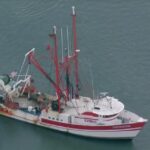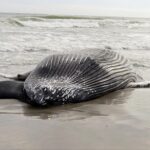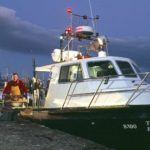Tag Archives: Seafood

How the Alabama Seafood Labeling Law is affecting Gulf Coast industry
Almost a year after being signed into law, residents should be beginning to see impacts the Alabama Seafood Labeling Law is having on the local industry. The Seafood Labeling Law was signed into law in May 2024, requiring in-state food establishments, such as grocery stores, restaurants, food trucks and in-store delis, to disclose and label whether any seafood being served was imported or domestically produced, as well as whether the seafood was farm-raised or wild-caught. Sellers are encouraged, but not required, to disclose the country of origin of imported foreign fish or shellfish. It also requires seafood suppliers who sell to these establishments within the state to disclose the country of origin so the retailers can accurately inform customers. It does not apply to ingredients in processed food. more, >>CLICK TO READ<< 07:47
The Vietnamese Impact on Jefferson Parish’s Seafood Industry
 For centuries, the Port of New Orleans has been the entry point for immigrants arriving in the country. Many of those immigrants took jobs in local industries, like fishing. Perhaps no other immigrant community has contributed more to the fishing industry in Louisiana than Vietnamese Americans. Among the more recent ethnic groups to settle in the state, many came as refugees, fleeing their war-torn homeland after the fall of Saigon in 1975. For many newcomers, the fishing industry was an easy transition. They simply had to adapt their knowledge of fishing in Vietnam’s swamps and coastlines to those of Louisiana. Today, almost two-thirds of Southeast Louisiana’s commercial shrimping fleets are made up of Vietnamese Americans. Their contributions didn’t stop at simply being laborers, though. Vietnamese immigrants also brought with them their recipes and cooking techniques, infusing them with traditional Southeast Louisiana cuisine. more, >>CLICK TO READ<< 07:50
For centuries, the Port of New Orleans has been the entry point for immigrants arriving in the country. Many of those immigrants took jobs in local industries, like fishing. Perhaps no other immigrant community has contributed more to the fishing industry in Louisiana than Vietnamese Americans. Among the more recent ethnic groups to settle in the state, many came as refugees, fleeing their war-torn homeland after the fall of Saigon in 1975. For many newcomers, the fishing industry was an easy transition. They simply had to adapt their knowledge of fishing in Vietnam’s swamps and coastlines to those of Louisiana. Today, almost two-thirds of Southeast Louisiana’s commercial shrimping fleets are made up of Vietnamese Americans. Their contributions didn’t stop at simply being laborers, though. Vietnamese immigrants also brought with them their recipes and cooking techniques, infusing them with traditional Southeast Louisiana cuisine. more, >>CLICK TO READ<< 07:50

The mystery and method of ‘market price’ seafood
To better understand how the market price of a lobster roll or other local delicacy is set by the time it reaches the consumer, Times Review reached out to fishermen, retail and wholesale seafood purveyors, restaurants, chefs and major regional distributors. Only a half-dozen experts were willing to speak on the record, and most insisted on anonymity. The seeming absurdity of sending so much fresh fish on an 80-plus mile round trip to and from New York City makes more sense considering that the price fluctuations that govern the fresh seafood market are driven by a variety of factors, from the uncertainty of boat fuel and trucking costs to overheads including refrigeration, labor, food preparation and the vacillating scarcity or availability of any popular fish. >>click to read<< 12:22
Imported shrimp eaten in U.S. may not be safe – U.S. Rep. Castor wants to do something about it
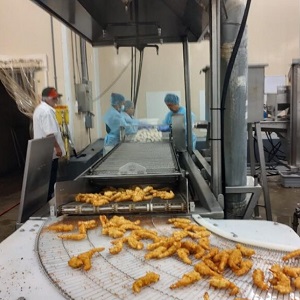 With inventories of shrimp sitting at docks throughout the Gulf Coast due to an abundance of imported seafood, the shrimp industry and U.S. Rep. Kathy Castor of Florida want to increase the purchase of domestic shrimp in the United States and provide more federal funding to regulate imported shrimp for consumers. John Williams is the executive director of the Southern Shrimp Alliance, which represents members of the shrimp industry from Texas through North Carolina. He said a lot of his members that are suffering right now. Castor’s bill, the Laws Ensuring Safe Shrimp Act (LESS Act) would address that issue by vastly increasing funding for the FDA to do inspections of foreign produced shrimp. >click to read< 16:07
With inventories of shrimp sitting at docks throughout the Gulf Coast due to an abundance of imported seafood, the shrimp industry and U.S. Rep. Kathy Castor of Florida want to increase the purchase of domestic shrimp in the United States and provide more federal funding to regulate imported shrimp for consumers. John Williams is the executive director of the Southern Shrimp Alliance, which represents members of the shrimp industry from Texas through North Carolina. He said a lot of his members that are suffering right now. Castor’s bill, the Laws Ensuring Safe Shrimp Act (LESS Act) would address that issue by vastly increasing funding for the FDA to do inspections of foreign produced shrimp. >click to read< 16:07

Different Ways to Cook the Perfect Scallops
It’s no surprise that scallops are a favorite of seafood lovers. Tender and slightly sweet, when properly prepared, they’re a culinary marvel. And, with a bit of guidance, you can create restaurant-worthy scallops right at home. Scallops can also be purchased either wet or dry. Opt for dry scallops whenever possible for a better taste and texture. Now that you have some background on which scallops to buy, let’s get cooking! Some excellent recipes for Seared Scallops, Grilled Scallops, Scallops in Cream Sauce, and many more! >click to read< 09:55
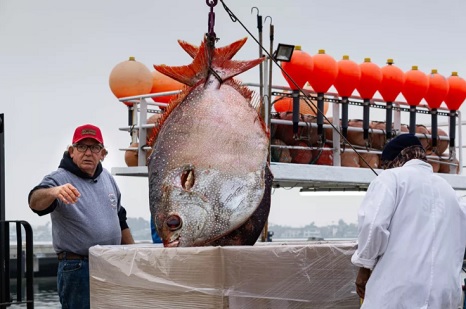
“The Fishmonger” Tommy Gomes to Star in TV Show and Open Point Loma Seafood Market
San Diego’s seafood culture, from its fishermen to the city’s chefs and restaurants, will be the subject of a new television show premiering Monday, March 1, on the Outdoor Channel. The Fishmonger stars local seafood expert Tommy Gomes, a native San Diegan and former commercial fisherman whose long career in the industry includes 15 years with Catalina Offshore Products, where he founded a walk-in fish market for the wholesaler and started a educational dinner series. >click to read< 08:50

“Seared Diver Scallops”: In these tough economic times, this dive harvester is trying to keep money in the province
Through late summer and early fall, Tim Ball spent as much time as possible underwater in his dive gear, scouring the seabed off the Burin Peninsula for scallops. It’s an ocean-to-table operation that sees his hand-harvested scallops quickly making their way to dinner plates in the downtown of St.  John’s. Terre Restaurant in St. John’s is one of the destinations for Ball’s scallops. For Ball, that means, among other things, using locally made bags and boxes for packing his scallops and using a Burin Peninsula cab company for sending his catch into St. John’s. “They’re amazing,” said head chef Matthew Swift. “Anywhere else in the world … the idea of marketing day boat scallops is sort of a pipe dream. >click to read< 09:04
John’s. Terre Restaurant in St. John’s is one of the destinations for Ball’s scallops. For Ball, that means, among other things, using locally made bags and boxes for packing his scallops and using a Burin Peninsula cab company for sending his catch into St. John’s. “They’re amazing,” said head chef Matthew Swift. “Anywhere else in the world … the idea of marketing day boat scallops is sort of a pipe dream. >click to read< 09:04

B.C. harvests 196,000 tonnes of fish a year. Most of it is exported and that’s a problem
There are about 4,000 fish harvesters scattered across the province who harvested about 196,000 tonnes of wild seafood in 2018, worth $476 million, everything from salmon to crab to geoducks. Most of that seafood didn’t stay in Canada. The province exports all but about 15 per cent of its annual catch each year and, like most of Canada, imports between 70 and 90 per cent of the seafood British Columbians eat, according to federal data. The licensing policies that give fish harvesters the right to fish the B.C. coast have privatized access to seafood and put them on the open market. >click to read< 07:50

On the fishing docks of Point Judith: Sales are down, but they still work hard in the heat
She was surrounded by 450-pound barrels of the bottom fish, brought in by draggers. Despite wholesale lobster prices being down from the pandemic, boats are still going out to scratch out a paycheck. It’s all they have. Andrea was wearing orange oilers and rubber boots in the sun, driving a huge needle through four frisbee-size skates at a time to make a “string.” The bait not only lures lobsters but is good eating for them during the days they’re in traps before being hauled. Andrea joked that her skates are what makes lobsters taste good. I asked how old she is. She smiled and said, “None of your business,” then allowed she might be in her mid-60s. She’s a longtime fixture on the docks, having started “The Bait Company” there 36 years ago to serve the big boats that go out to sea. photos, >click to read< 22:15

Always Top Quality! Your Seafreeze Ltd. Price Sheet for July 2020 Has Arrived!
Contact our sales team today! To review the complete price list from Seafreeze Ltd., >Click here< – “The only thing we treat our fish with, is respect” Seafreeze Ltd! >Click here< to visit our website! 10:43

Fresh fish market proposed for Oceanside harbor to sell Seafood direct to consumers!
A group of local commercial fishermen hopes to create a weekly market at the Oceanside harbor where they could sell their catch directly to consumers. The idea sprang up as a result of the Coronavirus crisis, which closed sit-down restaurants everywhere. That greatly reduced the fishermen’s sales and left them looking for new outlets. Some of them decided to cut out the middleman and try selling their products to people at the harbor.,, Among the issues to be decided is whether the market will be overseen by a board of directors, elected by the fishermen, that would establish rules and guidelines for the venture,,, >click to read< 10:41

Pacific Seafoods Charleston branch unaffected by coronavirus
While the Newport branch of Pacific Seafood has recorded 124 positive cases of COVID-19, the Charleston branch of the same company has been unaffected. “The cluster of COVID-19 cases in Newport has not impacted our operations or team members in Charleston. No workers from Newport have relocated to Charleston, or to any other facilities,” said Lacy Ogan,,, Pacific Seafood in Charleston has reported that safety precautions are in place. These steps have included increased cleaning protocols, face coverings, daily temperature checks, staggered shifts to allow for less people together and restricted access provided to the facility. >click to read< 16:43

In Newport, a coronavirus outbreak spreads to local economy
Pacific Seafood ceased operations at all five of its Newport plants. The Oregon Health Authority said the outbreak is contained to Lincoln County and that risk to the public is low. But Newport Mayor Dean Sawyer said most of those who tested positive are locals. The town’s economy is hurting again without a major fish buyer and supplier. And businesses are shutting back down to try to slow the spread of the virus. “They live here, they work here, they’re community-based people,” Sawyer said. “And, of course, the problem with that is that people live and work with people that work in other industries.” >click to read< 12:16

The U.S.- China trade agreement will slow Canadian lobster sales to China
Even though a new U.S.-China trade agreement does not eliminate heavy Chinese tariffs, the deal will result in a loss of Canadian seafood sales to China,,, Canadian live lobster exports to China, mostly from Nova Scotia, soared after China slapped retaliatory tariffs of 35 per cent on U.S. lobsters. U.S. lobster exports tanked while Canadian sales jumped,,, The new trade deal does not lower those tariffs. But China has pledged to buy $32 billion worth of American agricultural products over the next two years, including lobster and other seafood products. >click to read< 17:38

Enjoying seafood is a Pensacola tradition, but how did it begin?
Since harvesting creatures with fins and shells has long been with us it may make a bit of sense to periodically look at some highlights, ventures that seemingly evade the printed pages. One such story made local news print in the 1840s. It was in that decade that a number of venturesome fishermen out of New England believed that they had overcome one of their seasonal problems. Wintertime angling in the stormy Atlantic was hazardous, and often bitter cold, thus a few crews began to experiment, trading information they’d received about how plentiful snapper and grouper were in the Gulf. >click to read< 11:47

Wasted – Our global food system discards 46 million tonnes of fish each year. Why?
From the moment a fisher lands a fish to the moment that fish lands on your plate, 27 percent of it will disappear.,,,It may surprise you, then, to learn that the Seafood Expo North America in Boston, Massachusetts, the largest gathering of the seafood industry in North America, does not stink. Not really. It smells of cleaned carpet and newly printed brochures and freshly scrubbed businesspeople, of men in ironed shirts and women with flat-ironed hair.,,, Around 22,000 people come from 50 countries to buy, sell, and market every consumable marine product imaginable. >click to read< 13:36

Floods in Midwest take toll on seafood in Gulf Coast area
Mississippi Gov. Phil Bryant and Louisiana Gov. John Bel Edwards have asked the federal government for a fisheries disaster declaration,,, Louisiana’s oyster harvest is 80% below average,,, “We’ve been dealing with the river since October,” said Acy J. Cooper Jr., president of the Louisiana Shrimp Association “That’s a long time it’s been high.” The die-offs are as bad in Mississippi.,, Shrimp are now in places only larger boats can reach, said Cooper. “Some of the big ones are catching a few,” he said. “The smaller boats are just catching hell.” >Video, click to read< 18:05

What About Carlos Rafael, His Permits and His Boats? [OPINION]
There has been little public talk about “The Codfather” and his fishing empire since he was sentenced to federal prison for crimes related to fishing. In September of 2017, Judge William Young sentenced Carlos “The Codfather” Rafael to 46 months in federal prison. Additionally, Judge Young fined him $200,000 and three years supervised probation after his release from prison.,,, hearing rumors that two big players have emerged as the buyers of the boats and the all-important federal permits. One buyer wants the groundfish operation and one wants the scallop operation. There is concern locally that “Wall Street money” is coming in to buy up the local operations. >click to read<08:21

Don Cuddy – Seafood comes in many forms — how fresh is yours?
We live, as we are often reminded, in the top grossing fishing port in the United States and have some of the planet’s most productive fishing grounds right off our shores. So for those among us who enjoy and appreciate the harvest of the sea, and its clean, healthy, wild-caught protein, there is no better place to live than New Bedford. Lately however I have begun to wonder just how many people around the SouthCoast are fish eaters and include our excellent seafood as a regular part of their diet? Apart from perhaps ordering fish and chips or fried scallops in a restaurant on a Friday night that is. That counts certainly but what I have in mind is selecting some seafood at the market and bringing it home. >click to read<12:29
Seafood sold in U.S. grocery stores is being processed by North Korean labor
 The case for knowing where your food comes from grows ever stronger: A new Associated Press investigation reveals America’s hunger for seafood is unwittingly helping fund the North Korean dictatorship. According to the report, North Korea is outsourcing workers to plants in China that process seafood, including wild-caught salmon, snow crab, and squid, that’s sold in U.S. grocery stores such as Walmart and Aldi — meaning American grocery shoppers “may inadvertently have subsidized the North Korean government as it builds its nuclear weapons program.” click here to read the story 22:31
The case for knowing where your food comes from grows ever stronger: A new Associated Press investigation reveals America’s hunger for seafood is unwittingly helping fund the North Korean dictatorship. According to the report, North Korea is outsourcing workers to plants in China that process seafood, including wild-caught salmon, snow crab, and squid, that’s sold in U.S. grocery stores such as Walmart and Aldi — meaning American grocery shoppers “may inadvertently have subsidized the North Korean government as it builds its nuclear weapons program.” click here to read the story 22:31
Projects approved under NL’s seafood innovation and transition program
 The provincial government has approved approximately $1.8 million so far this year as part of the $2-million seafood innovation and transition program for 2017-18. To date, applications from 62 projects have been approved for funding, up from 37 the previous year. “Last year, the production value of our seafood sector reached yet another record high, exceeding $1.4 billion,” Fisheries and Land Resources Minister Gerry Byrne said in a news release. The following is a list of project that have been approved click here to read the story 20:19
The provincial government has approved approximately $1.8 million so far this year as part of the $2-million seafood innovation and transition program for 2017-18. To date, applications from 62 projects have been approved for funding, up from 37 the previous year. “Last year, the production value of our seafood sector reached yet another record high, exceeding $1.4 billion,” Fisheries and Land Resources Minister Gerry Byrne said in a news release. The following is a list of project that have been approved click here to read the story 20:19
Niaz Dorry of Northwest Atlantic Marine Alliance – Top 10 Myths About Seafood, Fisheries, and Marine Conservation
 To me, from the start it was these similarities that were the untold story of the ocean and fisheries work. Some of the items on the list – like #1 – were clear to me from day one. Others emerged as I learned more. My convictions about this list are a manifestation of my instincts that are often reinforced through experience and information. 10. We need stability, so we can’t change the current system. This is code word for maintaining status quo. In some ways, they are right; we can’t change the current system. At least not in ways that will matter, so at some point we will need to start from scratch. It’s like a bad batch of dough. Nothing you do is going to fix it. In the end, you’ll have a loaf of brick. Time to start anew. And this time,,, Read the rest here 15:17
To me, from the start it was these similarities that were the untold story of the ocean and fisheries work. Some of the items on the list – like #1 – were clear to me from day one. Others emerged as I learned more. My convictions about this list are a manifestation of my instincts that are often reinforced through experience and information. 10. We need stability, so we can’t change the current system. This is code word for maintaining status quo. In some ways, they are right; we can’t change the current system. At least not in ways that will matter, so at some point we will need to start from scratch. It’s like a bad batch of dough. Nothing you do is going to fix it. In the end, you’ll have a loaf of brick. Time to start anew. And this time,,, Read the rest here 15:17
How And When Some Seafood Is Mislabeled And Mistreated
 In reporting our inaugural episode of Food Crimes, we began to suspect that maybe our only hope for ever eating seafood worry-free again was to either begin a direct relationship with a fisherman or to become fishermen ourselves. This graphic—the result of a great many sources deep inside the seafood industry—confirms it. See the graphic here 16:24
In reporting our inaugural episode of Food Crimes, we began to suspect that maybe our only hope for ever eating seafood worry-free again was to either begin a direct relationship with a fisherman or to become fishermen ourselves. This graphic—the result of a great many sources deep inside the seafood industry—confirms it. See the graphic here 16:24








































